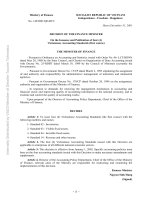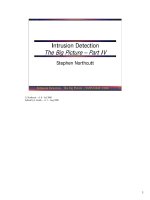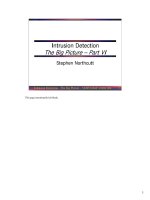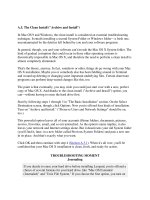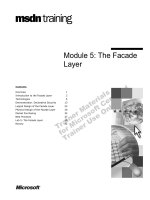Tài liệu We trip the light fantastic pdf
Bạn đang xem bản rút gọn của tài liệu. Xem và tải ngay bản đầy đủ của tài liệu tại đây (5.81 MB, 262 trang )
Information Security
FUNDAMENTALS
Copyright 2005 by CRC Press, LLC. All Rights Reserved.
AUERBACH PUBLICATIONS
www.auerbach-publications.com
To Order Call: 1-800-272-7737 • Fax: 1-800-374-3401
E-mail:
Asset Protection and Security Management
Handbook
POA Publishing
ISBN: 0-8493-1603-0
Building a Global Information Assurance
Program
Raymond J. Curts and Douglas E. Campbell
ISBN: 0-8493-1368-6
Building an Information Security Awareness
Program
Mark B. Desman
ISBN: 0-8493-0116-5
Critical Incident Management
Alan B. Sterneckert
ISBN: 0-8493-0010-X
Cyber Crime Investigator's Field Guide
Bruce Middleton
ISBN: 0-8493-1192-6
Cyber Forensics: A Field Manual for Collecting,
Examining, and Preserving Evidence of
Computer Crimes
Albert J. Marcella, Jr. and Robert S. Greenfield
ISBN: 0-8493-0955-7
The Ethical Hack: A Framework for Business
Value Penetration Testing
James S. Tiller
ISBN: 0-8493-1609-X
The Hacker's Handbook: The Strategy Behind
Breaking into and Defending Networks
Susan Young and Dave Aitel
ISBN: 0-8493-0888-7
Information Security Architecture:
An Integrated Approach to Security in the
Organization
Jan Killmeyer Tudor
ISBN: 0-8493-9988-2
Information Security Fundamentals
Thomas R. Peltier
ISBN: 0-8493-1957-9
Information Security Management Handbook,
5th Edition
Harold F. Tipton and Micki Krause
ISBN: 0-8493-1997-8
Information Security Policies, Procedures, and
Standards: Guidelines for Effective Information
Security Management
Thomas R. Peltier
ISBN: 0-8493-1137-3
Information Security Risk Analysis
Thomas R. Peltier
ISBN: 0-8493-0880-1
Information Technology Control and Audit
Fredrick Gallegos, Daniel Manson,
and Sandra Allen-Senft
ISBN: 0-8493-9994-7
Investigator's Guide to Steganography
Gregory Kipper
0-8493-2433-5
Managing a Network Vulnerability Assessment
Thomas Peltier, Justin Peltier, and John A. Blackley
ISBN: 0-8493-1270-1
Network Perimeter Security: Building Defense
In-Depth
Cliff Riggs
ISBN: 0-8493-1628-6
The Practical Guide to HIPAA Privacy and
Security Compliance
Kevin Beaver and Rebecca Herold
ISBN: 0-8493-1953-6
A Practical Guide to Security Engineering and
Information Assurance
Debra S. Herrmann
ISBN: 0-8493-1163-2
The Privacy Papers: Managing Technology,
Consumer, Employee and Legislative Actions
Rebecca Herold
ISBN: 0-8493-1248-5
Public Key Infrastructure: Building Trusted
Applications and Web Services
John R. Vacca
ISBN: 0-8493-0822-4
Securing and Controlling Cisco Routers
Peter T. Davis
ISBN: 0-8493-1290-6
Strategic Information Security
John Wylder
ISBN: 0-8493-2041-0
Surviving Security: How to Integrate People,
Process, and Technology, Second Edition
Amanda Andress
ISBN: 0-8493-2042-9
A Technical Guide to IPSec Virtual
Private Networks
James S. Tiller
ISBN: 0-8493-0876-3
Using the Common Criteria for IT Security
Evaluation
Debra S. Herrmann
ISBN: 0-8493-1404-6
OTHER INFORMATION SECURITY BOOKS FROM AUERBACH
Copyright 2005 by CRC Press, LLC. All Rights Reserved.
AUERBACH PUBLICATIONS
A CRC Press Company
Boca Raton London New York Washington, D.C.
Information Security
FUNDAMENTALS
Thomas R. Peltier
Justin Peltier
John Blackley
Copyright 2005 by CRC Press, LLC. All Rights Reserved.
This book contains information obtained from authentic and highly regarded sources. Reprinted material
is quoted with permission, and sources are indicated. A wide variety of references are listed. Reasonable
efforts have been made to publish reliable data and information, but the author and the publisher cannot
assume responsibility for the validity of all materials or for the consequences of their use.
Neither this book nor any part may be reproduced or transmitted in any form or by any means, electronic
or mechanical, including photocopying, microfilming, and recording, or by any information storage or
retrieval system, without prior permission in writing from the publisher.
The consent of CRC Press does not extend to copying for general distribution, for promotion, for creating
new works, or for resale. Specific permission must be obtained in writing from CRC Press LLC for such
copying.
Direct all inquiries to CRC Press, 2000 N.W. Corporate Blvd., Boca Raton, Florida 33431.
Trademark Notice:
Product or corporate names may be trademarks or registered trademarks, and are
used only for identification and explanation, without intent to infringe.
Visit the CRC Press Web site at www.crcpress.com
© 2005 by CRC Press LLC
Auerbach is an imprint of CRC Press LLC
No claim to original U.S. Government works
International Standard Book Number 0-8493-1957-9
Library of Congress Card Number 2004051024
Printed in the United States of America 1 2 3 4 5 6 7 8 9 0
Printed on acid-free paper
Library of Congress Cataloging-in-Publication Data
Peltier, Thomas R.
Information security fundamentals / Thomas R. Peltier, Justin Peltier, John Blackley.
p. cm.
Includes bibliographical references and index.
ISBN 0-8493-1957-9 (alk. paper)
1. Computer security. 2. Data protection. I. Peltier, Justin. II. Blackley, John A. III.
Title.
QA76.9.A25P427 2004
005.8—dc22 2004051024
Copyright 2005 by CRC Press, LLC. All Rights Reserved.
Dedication
To our spouses, friends, children, and colleagues; without them we would
be without direction, support, and joy.
AU1957_C000.fm Page v Monday, September 20, 2004 3:19 PM
Copyright 2005 by CRC Press, LLC. All Rights Reserved.
Contents
Acknowledgments
Introduction
Chapter 1
Overview
1.1 Elements of Information Protection
1.2 More Than Just Computer Security
1.2.1 Employee Mind-Set toward Controls
1.3 Roles and Responsibilities
1.3.1 Director, Design and Strategy
1.4 Common Threats
1.5 Policies and Procedures
1.6 Risk Management
1.7 Typical Information Protection Program
1.8 Summary
Chapter 2
Threats to Information Security
2.1 What Is Information Security?
2.2 Common Threats
2.2.1 Errors and Omissions
2.2.2 Fraud and Theft
2.2.3 Malicious Hackers
2.2.4 Malicious Code
2.2.5 Denial-of-Service Attacks
2.2.6 Social Engineering
2.2.7 Common Types of Social Engineering
2.3 Summary
Chapter 3
The Structure of an Information Security
Program
3.1 Overview
3.1.1 Enterprisewide Security Program
AU1957_C000.fm Page vii Monday, September 20, 2004 3:19 PM
Copyright 2005 by CRC Press, LLC. All Rights Reserved.
3.2 Business Unit Responsibilities
3.2.1 Creation and Implementation of Policies and Standards
3.2.2 Compliance with Policies and Standards
3.3 Information Security Awareness Program
3.3.1 Frequency
3.3.2 Media
3.4 Information Security Program Infrastructure
3.4.1 Information Security Steering Committee
3.4.2 Assignment of Information Security Responsibilities
3.4.2.1 Senior Management
3.4.2.2 Information Security Management
3.4.2.3 Business Unit Managers
3.4.2.4 First Line Supervisors
3.4.2.5 Employees
3.4.2.6 Third Parties
3.5 Summary
Chapter 4
Information Security Policies
4.1 Policy Is the Cornerstone
4.2 Why Implement an Information Security Policy
4.3 Corporate Policies
4.4 Organizationwide (Tier 1) Policies
4.4.1 Employment
4.4.2 Standards of Conduct
4.4.3 Conflict of Interest
4.4.4 Performance Management
4.4.5 Employee Discipline
4.4.6 Information Security
4.4.7 Corporate Communications
4.4.8 Workplace Security
4.4.9 Business Continuity Plans (BCPs)
4.4.10 Procurement and Contracts
4.4.11 Records Management
4.4.12 Asset Classification
4.5 Organizationwide Policy Document
4.6 Legal Requirements
4.6.1 Duty of Loyalty
4.6.2 Duty of Care
4.6.3 Federal Sentencing Guidelines for Criminal Convictions
4.6.4 The Economic Espionage Act of 1996
4.6.5 The Foreign Corrupt Practices Act (FCPA)
4.6.5 Sarbanes–Oxley (SOX) Act
4.6.6 Health Insurance Portability and Accountability
Act (HIPAA)
4.6.7 Gramm–Leach–Bliley Act (GLBA)
4.7 Business Requirements
AU1957_C000.fm Page viii Monday, September 20, 2004 3:19 PM
Copyright 2005 by CRC Press, LLC. All Rights Reserved.
4.8 Definitions
4.8.1 Policy
4.8.2 Standards
4.8.3 Procedures
4.8.4 Guidelines
4.9 Policy Key Elements
4.10 Policy Format
4.10.1 Global (Tier 1) Policy
4.10.1.1 Topic
4.10.1.2 Scope
4.10.1.3 Responsibilities
4.10.1.4 Compliance or Consequences
4.10.1.5 Sample Information Security Global Policies
4.10.2 Topic-Specific (Tier 2) Policy
4.10.2.1 Thesis Statement
4.10.2.2 Relevance
4.10.2.3 Responsibilities
4.10.2.4 Compliance
4.10.2.5 Supplementary Information
4.10.3 Application-Specific (Tier 3) Policy
4.11 Summary
Chapter 5
Asset Classification
5.1 Introduction
5.2 Overview
5.3 Why Classify Information?
5.4 What Is Information Classification?
5.5 Where to Begin?
5.6 Information Classification Category Examples
5.6.1 Example 1
5.6.2 Example 2
5.6.3 Example 3
5.6.4 Example 4
5.7 Resist the Urge to Add Categories
5.8 What Constitutes Confidential Information
5.8.1 Copyright
5.9 Employee Responsibilities
5.9.1 Owner
5.9.1.1 Information Owner
5.9.2 Custodian
5.9.3 User
5.10 Classification Examples
5.10.1 Classification: Example 1
5.10.2 Classification: Example 2
5.10.3 Classification: Example 3
5.10.4 Classification: Example 4
AU1957_C000.fm Page ix Monday, September 20, 2004 3:19 PM
Copyright 2005 by CRC Press, LLC. All Rights Reserved.
5.11 Declassification or Reclassification of Information
5.12 Records Management Policy
5.12.1 Sample Records Management Policy
5.13 Information Handling Standards Matrix
5.13.1 Printed Material
5.13.2 Electronically Stored Information
5.13.3 Electronically Transmitted Information
5.13.4 Record Management Retention Schedule
5.14 Information Classification Methodology
5.15 Authorization for Access
5.15.1 Owner
5.15.2 Custodian
5.15.3 User
5.16 Summary
Chapter 6
Access Control
6.1 Business Requirements for Access Control
6.1.1 Access Control Policy
6.2 User Access Management
6.2.1 Account Authorization
6.2.2 Access Privilege Management
6.2.3 Account Authentication Management
6.3 System and Network Access Control
6.3.1 Network Access and Security Components
6.3.2 System Standards
6.3.3 Remote Access
6.4 Operating System Access Controls
6.4.1 Operating Systems Standards
6.4.2 Change Control Management
6.5 Monitoring System Access
6.5.1 Event Logging
6.5.2 Monitoring Standards
6.5.3 Intrusion Detection Systems
6.6 Cryptography
6.6.1 Definitions
6.6.2 Public Key and Private Key
6.6.3 Block Mode, Cipher Block, and Stream Ciphers
6.6.4 Cryptanalysis
6.7 Sample Access Control Policy
6.8 Summary
Chapter 7
Physical Security
7.1 Data Center Requirements
7.2 Physical Access Controls
AU1957_C000.fm Page x Monday, September 20, 2004 3:19 PM
Copyright 2005 by CRC Press, LLC. All Rights Reserved.
7.2.1 Assets to be Protected
7.2.2 Potential Threats
7.2.3 Attitude toward Risk
7.2.4 Sample Controls
7.3 Fire Prevention and Detection
7.3.1 Fire Prevention
7.3.2 Fire Detection
7.3.3 Fire Fighting
7.4 Verified Disposal of Documents
7.4.1 Collection of Documents
7.4.2 Document Destruction Options
7.4.3 Choosing Services
7.5 Agreements
7.5.1 Duress Alarms
7.6 Intrusion Detection Systems
7.6.1 Purpose
7.6.2 Planning
7.6.3 Elements
7.6.4 Procedures
7.7 Sample Physical Security Policy
7.8 Summary
Chapter 8
Risk Analysis and Risk Management
8.1 Introduction
8.2 Frequently Asked Questions on Risk Analysis
8.2.1 Why Conduct a Risk Analysis?
8.2.2 When to Conduct a Risk Analysis?
8.2.3 Who Should Conduct the Risk Analysis?
8.2.4 How Long Should a Risk Analysis Take?
8.2.5 What a Risk Analysis Analyzes
8.2.6 What Can the Results of a Risk Analysis Tell an
Organization?
8.2.7 Who Should Review the Results of a Risk Analysis?
8.2.8 How Is the Success of the Risk Analysis Measured?
8.3 Information Security Life Cycle
8.4 Risk Analysis Process
8.4.1 Asset Definition
8.4.2 Threat Identification
8.4.3 Determine Probability of Occurrence
8.4.4 Determine the Impact of the Threat
8.4.5 Controls Recommended
8.4.6 Documentation
8.5 Risk Mitigation
8.6 Control Categories
AU1957_C000.fm Page xi Monday, September 20, 2004 3:19 PM
Copyright 2005 by CRC Press, LLC. All Rights Reserved.
8.7 Cost/Benefit Analysis
8.8 Summary
Chapter 9
Business Continuity Planning
9.1 Overview
9.2 Business Continuity Planning Policy
9.2.1 Policy Statement
9.2.2 Scope
9.2.3 Responsibilities
9.2.4 Compliance
9.3 Conducting a Business Impact Analysis (BIA)
9.3.1 Identify Sponsor(s)
9.3.2 Scope
9.3.3 Information Meeting
9.3.4 Information Gathering
9.3.5 Questionnaire Design
9.3.6 Scheduling the Interviews
9.3.7 Conducting Interviews
9.3.8 Tabulating the Information
9.3.9 Presenting the Results
9.4 Preventive Controls
9.5 Recovery Strategies
9.5.1 Hot Site, Cold Site, Warm Site, Mobile Site
9.5.2 Key Considerations
9.5.2.1 People
9.5.2.2 Communications
9.5.2.3 Computing Equipment
9.5.2.4 Facilities
9.6. Plan Construction, Testing, and Maintenance
9.6.1 Plan Construction
9.6.1.1 Crisis Management Plan
9.6.1.2 Plan Distribution
9.6.2 Plan Testing
9.6.2.1 Line Testing
9.6.2.2 Walk-through Testing
9.6.2.3 Single Process Testing
9.6.2.4 Full Testing
9.6.2.5 Plan Testing Summary
9.6.3 Plan Maintenance
9.7 Sample Business Continuity Plan Policy
9.8 Summary
Glossary
Bibliography
AU1957_C000.fm Page xii Monday, September 20, 2004 3:19 PM
Copyright 2005 by CRC Press, LLC. All Rights Reserved.
Acknowledgments
An organization that has moved to the forefront of creating usable infor-
mation for the information security professional is the National Institute
of Standards and Technology (NIST). The NIST 800 Series of Special
Publications is a great source of information that many security profes-
sionals have provided over the years. Joan Hash and the other dedicated
people who work at NIST have added greatly to the profession.
The Computer Security Institute (CSI) has been the leader in the
information security industry since 1974 and continues to provide leader-
ship and direction for its members and the industry as a whole. John
O’Leary has been the constant in all the changes seen in this industry.
The new CSI management team of Julie Hogan, Chris Keating, and Jennifer
Stevens continues to provide the tools and classes that the security
professional needs to be successful. The new team has blended well with
the CSI seasoned veterans of Pam Salaway, Kimber Heald, Frederic Martin,
Nancy Baer, and Joanna Kaufman.
No one has all of the answers to any question, so the really “smart”
person cultivates good friends. Having been in the information security
business for nearly 30 years, I have had the great good fortune of having
a number of such friends and fellow professionals. This group of long-
time sources of great information include Mike Corby, Terri Curran, Peter
Stephenson, Merrill Lynch, Bob Cartwright, Pat Howard, Cheryl and Carl
Jackson, Becky Herold, Ray Kaplan, Genny Burns, Anne Terwilliger,
Patrice Rapalus, David Lynas, John Sherwood, Herve Schmidt, Antonio
and Pietro Ruvolo, Wayne Sumida, Caroline Hamilton, Dan Erwin, Lisa
Bryson, and William H. Murray.
My working buddies must also be acknowledged. My son Justin is the
greatest asset any father — and more importantly, any information security
team — could ever hope for. Over the past two years, we have logged
AU1957_C000.fm Page xiii Monday, September 20, 2004 3:19 PM
Copyright 2005 by CRC Press, LLC. All Rights Reserved.
nearly 150,000 air miles together, and each day we learn something new
from each other.
The other working buddy is John Blackley, a strange Scotsman who
makes our life more fun and interesting. I have worked with John since
1985 and have marveled at how well he takes obtuse concepts and
condenses them so that even management types understand.
Who can leave out their publisher? Certainly not me; Rich O’Hanley
has taken the time to discuss security issues with numerous organizations
to understand what their needs are and then presented these findings to
us. A great deal of our work here is a direct result of what Rich discovered
the industry wanted. Rich O’Hanley, not only the world’s best editor and
task master, but a good friend and source of knowledge. Thanks Rich!
And finally I extend a thank-you to my editor Andrea Demby. She
takes the time to take the raw manuscript and put it into a logically
flowing work. She sometimes has to ask me the same question more than
once, but finally I get what needs to be done.
AU1957_C000.fm Page xiv Monday, September 20, 2004 3:19 PM
Copyright 2005 by CRC Press, LLC. All Rights Reserved.
Introduction
The purpose of information security is to protect an organization’s valuable
resources, such as information, computer hardware, and software. Through
the selection and application of appropriate safeguards, security helps the
organization’s mission by protecting its physical and financial resources,
reputation, legal position, employees, and other tangible and intangible
assets. To many, security is sometimes viewed as thwarting the business
objectives of the organization by imposing poorly selected, bothersome
rules and procedures on users, managers, and systems. Well-chosen secu-
rity rules and procedures do not exist for their own sake — they are put
in place to protect important assets and thereby support the overall
business objectives.
Developing an information security program that adheres to the prin-
ciple of security as a business enabler is the first step in an enterprise’s
effort to build an effective security program. Organizations must continually
(1) explore and assess information security risks to business operations;
(2) determine what policies, standards, and controls are worth implement-
ing to reduce these risks; (3) promote awareness and understanding among
the staff; and (4) assess compliance and control effectiveness. As with other
types of internal controls, this is a cycle of activity, not an exercise with
a defined beginning and end.
This book was designed to give the information security professional
a solid understanding of the fundamentals of security and the entire range
of issues the practitioner must address. We hope you will be able to take
the key elements that comprise a successful information security program
and implement the concepts into your own successful program.
AU1957_C000.fm Page xv Monday, September 20, 2004 3:19 PM
Copyright 2005 by CRC Press, LLC. All Rights Reserved.
Chapter 1
Overview
The purpose of information protection is to protect an organization’s
valuable resources, such as information, hardware, and software. Through
the selection and application of appropriate safeguards, security helps the
organization meet its business objectives or mission by protecting its
physical and financial resources, reputation, legal position, employees,
and other tangible and intangible assets. We will examine the elements
of computer security, employee roles and responsibilities, and common
threats. We will also examine the need for management controls, policies
and procedures, and risk analysis. Finally, we will present a comprehensive
list of tasks, responsibilities, and objectives that make up a typical infor-
mation protection program.
1.1 Elements of Information Protection
Information protection should be based on eight major elements:
1. Information protection should support the business objectives or
mission of the enterprise. This idea cannot be stressed enough. All
too often, information security personnel lose track of their goals
and responsibilities. The position of ISSO (Information Systems
Security Officer) has been created to support the enterprise, not
the other way around.
2. Information protection is an integral element of due care. Senior
management is charged with two basic responsibilities: a
duty of
AU1957_C001.fm Page 1 Monday, September 20, 2004 3:21 PM
Copyright 2005 by CRC Press, LLC. All Rights Reserved.
loyalty —
this means that whatever decisions they make must be
made in the best interest of the enterprise. They are also charged
with a
duty of care
— this means that senior management is
required to protect the assets of the enterprise and make informed
business decisions. An effective information protection program
will assist senior management in meeting these duties.
3. Information protection must be cost effective. Implementing con-
trols based on edicts is counter to the business climate. Before any
control can be proposed, it will be necessary to confirm that a
significant risk exists. Implementing a timely risk analysis process
can complete this. By identifying risks and then proposing appro-
priate controls, the mission and business objectives of the enterprise
will be better met.
4. Information protection responsibilities and accountabilities should
be made explicit. For any program to be effective, it will be
necessary to publish an information protection policy statement
and a group mission statement. The policy should identify the roles
and responsibilities of all employees. To be completely effective,
the language of the policy must be incorporated into the purchase
agreements for all contract personnel and consultants.
5. System owners have information protection responsibilities outside
their own organization. Access to information will often extend
beyond the business unit or even the enterprise. It is the respon-
sibility of the information owner (normally the senior level manager
in the business that created the information or is the primary user
of the information). One of the main responsibilities is to monitor
usage to ensure that it complies with the level of authorization
granted to the user.
6. Information protection requires a comprehensive and integrated
approach. To be as effective as possible, it will be necessary for
information protection issues to be part of the system development
life cycle. During the initial or analysis phase, information protec-
tion should receive as its deliverables a risk analysis, a business
impact analysis, and an information classification document. Addi-
tionally, because information is resident in all departments through-
out the enterprise, each business unit should establish an individual
responsible for implementing an information protection program
to meet the specific business needs of the department.
7. Information protection should be periodically reassessed. As with
anything, time changes the needs and objectives. A good informa-
tion protection program will examine itself on a regular basis and
make changes wherever and whenever necessary. This is a dynamic
AU1957_C001.fm Page 2 Monday, September 20, 2004 3:21 PM
Copyright 2005 by CRC Press, LLC. All Rights Reserved.
and changing process and therefore must be reassessed at least
every 18 months.
8. Information protection is constrained by the culture of the organi-
zation. The ISSO must understand that the basic information pro-
tection program will be implemented throughout the enterprise.
However, each business unit must be given the latitude to make
modifications to meet its specific needs. If your organization is
multinational, it will be necessary to make adjustments for each
of the various countries. These adjustments will have to be exam-
ined throughout the United States. What might work in Des Moines,
Iowa, may not fly in Berkeley, California. Provide for the ability
to find and implement alternatives.
Information protection is a means to an end and not the end in itself.
In business, having an effective information protection program is usually
secondary to the need to make a profit. In the public sector, information
protection is secondary to the agency’s services provided to its constancy.
We, as security professionals, must not lose sight of these goals and objectives.
Computer systems and the information processed on them are often
considered critical assets that support the mission of an organization.
Protecting them can be as important as protecting other organizational
resources such as financial resources, physical assets, and employees. The
cost and benefits of information protection should be carefully examined
in both monetary and nonmonetary terms to ensure that the cost of controls
does not exceed the expected benefits. Information protection controls
should be appropriate and proportionate.
The responsibilities and accountabilities of the information owners,
providers, and users of computer services and other parties concerned
with the protection of information and computer assets should be explicit.
If a system has external users, its owners have a responsibility to share
appropriate knowledge about the existence and general extent of control
measures so that other users can be confident that the system is adequately
secure. As we expand the user base to include suppliers, vendors, clients,
customers, shareholders, and the like, it is incumbent upon the enterprise
to have clear and identifiable controls. For many organizations, the initial
sign-on screen is the first indication that there are controls in place. The
message screen should include three basic elements:
1. The system is for authorized users only
2. That activities are monitored
3. That by completing the sign-on process, the user agrees to the
monitoring
AU1957_C001.fm Page 3 Monday, September 20, 2004 3:21 PM
Copyright 2005 by CRC Press, LLC. All Rights Reserved.
1.2 More Than Just Computer Security
Providing effective information protection requires a comprehensive
approach that considers a variety of areas both within and outside the
information technology area. An information protection program is more
than establishing controls for the computer-held data. In 1965 the idea of
the “paperless office” was first introduced. The advent of third-generation
computers brought about this concept. However, today the bulk of all of
the information available to employees and others is still found in printed
form. To be an effective program, information protection must move
beyond the narrow scope of IT and address the issues of enterprisewide
information protection. A comprehensive program must touch every stage
of the information asset life cycle from creation to eventual destruction.
1.2.1 Employee Mind-Set toward Controls
Access to information and the environments that process them are
dynamic. Technology and users, data and information in the systems, risks
associated with the system, and security requirements are ever changing.
The ability of information protection to support business objectives or the
mission of the enterprise may be limited by various factors, such as the
current mind-set toward controls.
A highly effective method of measuring the current attitude toward
information protection is to conduct a “walk-about.” After hours or on a
weekend, conduct a review of the workstations throughout a specific area
(usually a department or a floor) and look for just five basic control activities:
1. Offices secured
2. Desk and cabinets secured
3. Workstations secured
4. Information secured
5. Diskettes secured
When conducting an initial “walk-about,” the typical office environment
will have a 90 to 95 percent noncompliance rate with at least one of these
basic control mechanisms. The result of this review should be used to
form the basis for an initial risk analysis to determine the security require-
ments for the workstation. When conducting such a review, employee
privacy issues must be remembered.
1.3 Roles and Responsibilities
As discussed, senior management has the ultimate responsibility for pro-
tecting the organization’s information assets. One of these responsibilities
AU1957_C001.fm Page 4 Monday, September 20, 2004 3:21 PM
Copyright 2005 by CRC Press, LLC. All Rights Reserved.
is the establishment of the function of Corporate Information Officer (CIO).
The CIO directs the organization’s day-to-day management of information
assets. The ISSO and Security Administrator should report directly to the
CIO and are responsible for the day-to-day administration of the informa-
tion protection program.
Supporting roles are performed by the service providers and include
Systems Operations, whose personnel design and operate the computer
systems. They are responsible for implementing technical security on the
systems. Telecommunications is responsible for providing communication
services, including voice, data, video, and fax.
The information protection professional must also establish strong work-
ing relationships with the audit staff. If the only time you see the audit staff
is when they are in for a formal audit, then you probably do not have a
good working relationship. It is vitally important that this liaison be estab-
lished and that you meet to discuss common problems at least each quarter.
Other groups include the physical security staff and the contingency
planning group. These groups are responsible for establishing and imple-
menting controls and can form a peer group to review and discuss controls.
The group responsible for application development methodology will
assist in the implementation of information protection requirements in the
application system development life cycle. Quality Assurance can assist
in ensuring that information protection requirements are included in all
development projects prior to movement to production.
The Procurement group can work to get the language of the informa-
tion protection policies included in the purchase agreements for contract
personnel. Education and Training can assist in developing and conducting
information protection awareness programs and in training supervisors in
the responsibility to monitor employee activities. Human Resources will
be the organization responsible for taking appropriate action for any
violations of the organization’s information protection policy.
An example of a typical job description for an information security
professional is as follows:
1.3.1 Director, Design and Strategy
Location:
Anywhere, World
Practice Area:
Corporate Global Security Practice
Grade:
Purpose:
To create an information security design and
strategy practice that defines the technology structure
AU1957_C001.fm Page 5 Monday, September 20, 2004 3:21 PM
Copyright 2005 by CRC Press, LLC. All Rights Reserved.
needed to address the security needs of its clients. The
information security design and strategy will comple-
ment security and network services developed by the
other Global Practice areas. The design and strategy
practice will support the clients’ information technology
and architecture and integrate with each enterprise’s
business architecture. This security framework will pro-
vide for the secure operation of computing platforms,
operating systems, and networks, both voice and data,
to ensure the integrity of the clients’ information assets.
To work on corporate initiatives to develop and imple-
ment the highest quality security services and ensure
that industry best practices are followed in their imple-
mentation.
Working Relationships:
This position reports in the Global
Security Practice to the Vice President, Global Security.
Internal contacts are primarily Executive Management,
Practice Directors, Regional Management, as well as
mentoring and collaborating with consultants. This posi-
tion will directly manage two professional positions:
Manager, Service Provider Security Integration; and
Service Provider Security Specialist. Frequent external
contacts include building relationships with clients,
professional information security organizations, other
information security consultants; vendors of hardware,
software, and security services; and various regulatory
and legal authorities.
Principle Duties and Responsibilities:
The responsibilities
of the Director, Design and Strategy include, but are
not limited to, the following:
Ⅲ
Develop global information security services that will
provide the security functionality required to protect
clients’ information assets against unauthorized disclo-
sure, modification, and destruction. Particular focus ar-
eas include:
Ⅲ
Virtual private networks
– Data privacy
–Virus prevention
– Secure application architecture
– Service provider security solutions
AU1957_C001.fm Page 6 Monday, September 20, 2004 3:21 PM
Copyright 2005 by CRC Press, LLC. All Rights Reserved.
Ⅲ
Develop information security strategy services that can
adapt to clients’ diverse and changing technological
needs.
Ⅲ
Work with Network and Security practice leaders and
consultants; create sample architectures that communi-
cate the security requirements that will meet the needs
of all client network implementations.
Ⅲ
Work with practice teams to aid them from the concep-
tion phase to the deployment of the project solution.
This includes a quality assurance review to ensure that
the details of the project are correctly implemented
according to the service delivery methodology.
Ⅲ
Work with the clients to collect their business require-
ments for electronic commerce, while educating them
on the threats, vulnerabilities, and available risk miti-
gation strategies.
Ⅲ
Determine where and how you should use cryptogra-
phy to provide public key infrastructure and secure
messaging services for clients.
Ⅲ
Participate in security industry standards bodies to en-
sure that strategic information security needs will be
addressed.
Ⅲ
Conduct security focus groups with the clients to cultivate
an effective exchange of business plans, product devel-
opment, and marketing direction to aid in creating new
and innovative service offerings to meet client needs.
Ⅲ
Continually evaluate vendors’ product strategies and
future product statements, and advise which will be
most appropriate to pursue for alliances, especially in
the areas of:
–Virtual private networks
– Data privacy
–Virus prevention
– Secure application architecture
– Service provider security solutions
Ⅲ
Provide direction and oversight of hardware- and soft-
ware-based cryptography service development efforts.
Accountability:
Maintain the quality and integrity of the
services offered by the Global Security Practice. Review
and report impartially on the potential viability and prof-
itability of new security services. Assess the operational
AU1957_C001.fm Page 7 Monday, September 20, 2004 3:21 PM
Copyright 2005 by CRC Press, LLC. All Rights Reserved.
efficiency, compliance with industry standards, and
effectiveness of the client network designs and strate-
gies that are implemented through the company’s pro-
fessional service offerings. Exercise professional
judgment in making recommendations that may impact
business operations.
Knowledge and Skills:
Ⅲ
10 Percent Managerial and Practice Management:
– Ability to supervise a multidisciplinary team and a small
staff; must handle multiple tasks simultaneously; ability to
team with other Practice Directors and Managers to develop
strategic service offerings
–Willingness to manage or to personally execute necessary
tasks, as resources are required
– Excellent oral, written, and presentation skills
Ⅲ
40 Percent Technical:
– In-depth technical knowledge of information processing
platforms, operating systems, and networks in a global dis-
tributed environment
– Ability to identify and apply security techniques to develop
services to reduce clients’ risk in such an environment
–Technical experience in industrial security, computer sys-
tems architecture, design, and development, physical and
data security, telecommunications networks, auditing tech-
niques, and risk analysis principles
– Excellent visionary skills that focus on scalability, cost effec-
tiveness, and implementation ease
Ⅲ
20 Percent Business:
– Knowledge of business information flow in a multinational,
multiplatform networked environment
– Solid understanding of corporate dynamics and general busi-
ness processes; understanding of multiple industries
– Good planning and goal-setting skills
Ⅲ
20 Percent Interpersonal:
– Must possess strong consulting and communication skills
– Must have the ability to work with all levels of management
to resolve issues
– Must understand and differentiate between tactical and stra-
tegic concepts
– Must be able to weigh business needs with security require-
ments
– Must be self-motivating
AU1957_C001.fm Page 8 Monday, September 20, 2004 3:21 PM
Copyright 2005 by CRC Press, LLC. All Rights Reserved.



